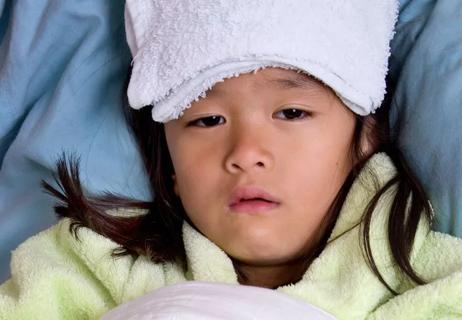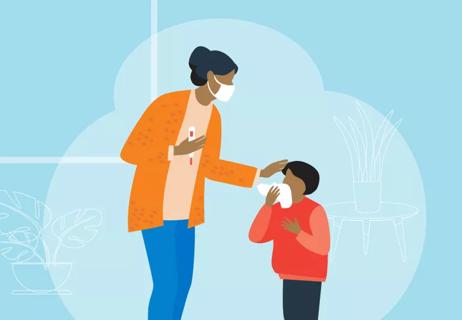A combination of rest, fluids and over-the-counter medications can help you feel better fast

You feel like you’re burning up — and the thermometer shows why. Your temperature just soared past 100.4 degrees Fahrenheit (38 degrees Celsius). Ugh. No wonder you feel so miserable.
Advertisement
Cleveland Clinic is a non-profit academic medical center. Advertising on our site helps support our mission. We do not endorse non-Cleveland Clinic products or services. Policy
So, how can you break a fever fast? We asked family medicine physician Neha Vyas, MD, for tips.
Given the body aches and fatigue that come with a fever, it’s hard to think of it as a good thing. But a fever is your body’s natural response to an infection or illness. It’s a sign that your immune system is taking a flamethrower to threats.
In most cases, you don’t necessarily need to break a mild fever that’s less than 101 F (38.3 C), says Dr. Vyas. It typically drops on its own once your body takes care of whatever drove your temperature up.
But if you’re feeling uncomfortable or your fever is high, here’s how to bring your temperature down to find relief.
Sleep is the best medicine for a fever. If you can’t doze off, curl up in bed or on the couch with a good movie, book or podcast.
“Your immune system needs rest to work properly,” says Dr. Vyas. “If you have a fever, stay home from work or school and lie down whenever you can. If you try to do too much, your fever and illness could last longer.”
So, resist the urge to tackle things on your to-do list when you have a fever. Save those chores for when you recover fully.
If you have a fever, you’re likely to sweat more — and it’s important to replenish those fluids.
Advertisement
“You can quickly get dehydrated if you’re not drinking enough when you have a fever,” emphasizes Dr. Vyas. “And when you’re dehydrated, it’s harder for your body to fight off an illness.”
Every system in your body — including your immune system — needs fluids to function at their best. Hydrating could help your fever (and illness) disappear as quickly as possible.
Options such as water, herbal tea or electrolyte-packed sports drinks can give your body reinforcements. Try to steer clear of caffeinated drinks. The reason? Caffeine makes you pee more, which can contribute to dehydration and interfere with your recovery.
That old adage about “starving a fever” isn’t quite accurate. Your body needs nutrients more than ever when it’s fighting off an illness or infection, notes Dr. Vyas.
So, try to get something down, even if your appetite isn’t at its usual level. Chicken soup is an ideal choice given that it’s hydrating, nutritious and packed with antioxidants to help you feel better.
If your fever leaves you feeling overheated, try cooling off by:
One important note to add: Skip the cooling methods if your fever is giving you chills. “You’ll likely feel worse if you try cooling off when you have chills, and that won’t help you relax and heal,” clarifies Dr. Vyas.
A fever can bring chills as your body adjusts to its higher temperature. Shivering is even a mechanism your body uses to generate heat through muscle activity to help boost your temperature. (Ironic, huh?)
So, if you’re feeling cold while burning up, it’s OK to cuddle up with a blanket or under the covers in bed.
But don’t bury yourself under a pile of quilts until you’re a sweaty mess.
“Too many blankets could raise your body temperature even more,” cautions Dr. Vyas. “Heating yourself up to the point where you start sweating could raise your risk of dehydration and be harmful.”
Over-the-counter pain relievers like acetaminophen and ibuprofen can help lower a fever while also treating headaches and body aches. But before you take or administer any medicine:
Aspirin can also be used to lower a fever for adults, but it shouldn’t be given to anyone under 18. Children who take aspirin increase their risk of Reye’s syndrome, a severe and potentially life-threatening condition.
Advertisement
If you do lean on medications, don’t do it to lower your temperature just so you can head to work or send your kids to school or daycare. In most cases, illnesses remain contagious for at least 24 hours after your fever breaks naturally without using medications.
“You could get people around you sick — and you’ll probably wear yourself out, which will likely make your fever and illness last longer,” warns Dr. Vyas.
While most fevers aren’t a reason to panic, sometimes, that high number on the thermometer deserves attention, says Dr. Vyas. Contact a healthcare provider about any fever that:
Seek immediate medical care if you have a fever and any of the following symptoms:
In young children with fevers who can’t communicate how they’re feeling, get medical attention if they:
Advertisement
Also, be wary of fevers if you’re immunocompromised or have ongoing health conditions (such as heart or lung diseases) because of the potential for complications.
“If you’re unsure about a fever or worried that it’s not just a mild illness, contact your provider,” advises Dr. Vyas. “It’s better to ask and get proper medical advice than to wait and worry. Your provider is there to help, so reach out if you’re concerned.”
Advertisement
Learn more about our editorial process.
Advertisement

Any fever, especially one of 100.5 degrees Fahrenheit or higher, should trigger a call to your oncologist — and maybe a trip to the ER

When your body is fighting infection, your internal temperature rises as a defensive response

Most cases are mild and can be treated at home, but some situations may require medical care or a trip to the ER

It can cause alcohol poisoning and other serious health issues, especially in kids

It’s important not to give them fever-reducing medications right off the bat

Is it just a passing chill or something more serious?

What you need to know about these common misconceptions

Start having sex about 72 hours before ovulation, then at least every other day during your fertile window

Attachment theory suggests that your earliest relationships shape connections throughout your life

It isn’t a recognized mental health disorder, but research shows that problematic social media use can negatively affect your mental health, self-esteem and sleep